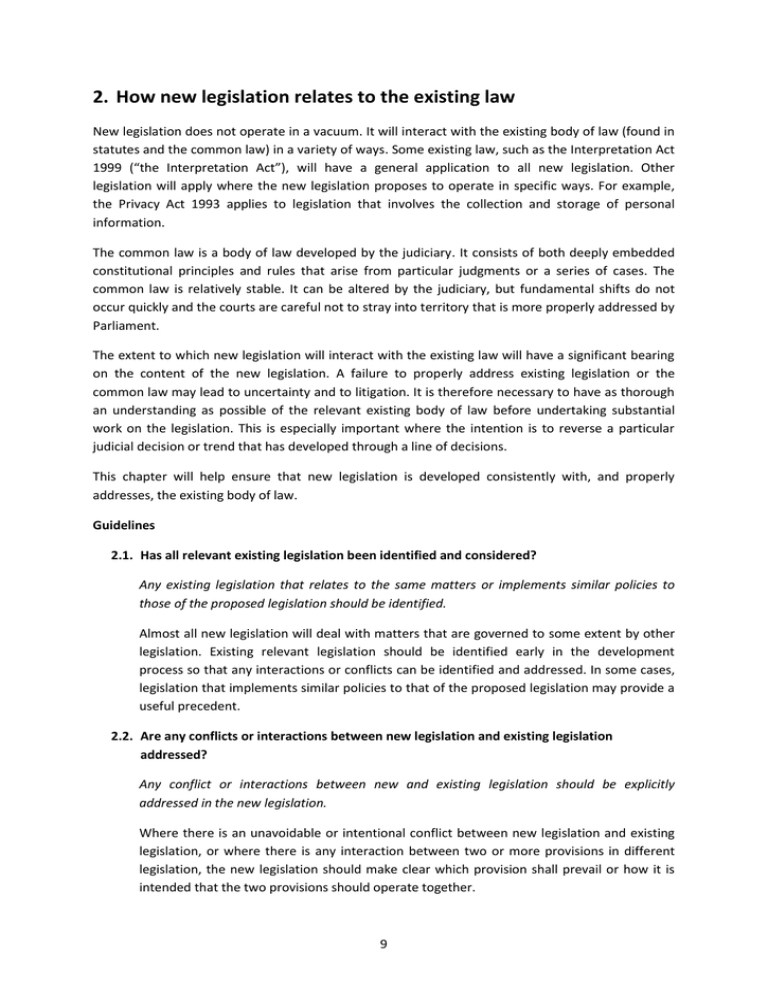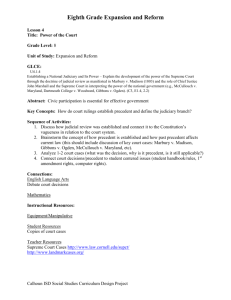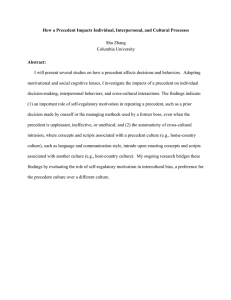2. How new legislation relates to the existing law (PDF 320 KB)
advertisement

2. How new legislation relates to the existing law New legislation does not operate in a vacuum. It will interact with the existing body of law (found in statutes and the common law) in a variety of ways. Some existing law, such as the Interpretation Act 1999 (“the Interpretation Act”), will have a general application to all new legislation. Other legislation will apply where the new legislation proposes to operate in specific ways. For example, the Privacy Act 1993 applies to legislation that involves the collection and storage of personal information. The common law is a body of law developed by the judiciary. It consists of both deeply embedded constitutional principles and rules that arise from particular judgments or a series of cases. The common law is relatively stable. It can be altered by the judiciary, but fundamental shifts do not occur quickly and the courts are careful not to stray into territory that is more properly addressed by Parliament. The extent to which new legislation will interact with the existing law will have a significant bearing on the content of the new legislation. A failure to properly address existing legislation or the common law may lead to uncertainty and to litigation. It is therefore necessary to have as thorough an understanding as possible of the relevant existing body of law before undertaking substantial work on the legislation. This is especially important where the intention is to reverse a particular judicial decision or trend that has developed through a line of decisions. This chapter will help ensure that new legislation is developed consistently with, and properly addresses, the existing body of law. Guidelines 2.1. Has all relevant existing legislation been identified and considered? Any existing legislation that relates to the same matters or implements similar policies to those of the proposed legislation should be identified. Almost all new legislation will deal with matters that are governed to some extent by other legislation. Existing relevant legislation should be identified early in the development process so that any interactions or conflicts can be identified and addressed. In some cases, legislation that implements similar policies to that of the proposed legislation may provide a useful precedent. 2.2. Are any conflicts or interactions between new legislation and existing legislation addressed? Any conflict or interactions between new and existing legislation should be explicitly addressed in the new legislation. Where there is an unavoidable or intentional conflict between new legislation and existing legislation, or where there is any interaction between two or more provisions in different legislation, the new legislation should make clear which provision shall prevail or how it is intended that the two provisions should operate together. 9 2.3. Are any matters addressed by the new legislation covered by existing legislation? New legislation should not re-state matters that are already addressed in existing legislation. Where a provision in existing legislation satisfactorily addresses an issue, it is preferable not to repeat that provision in new legislation. This kind of duplication often results in unintended differences, especially where legislation is amended over time or where the legislation is intended to address a different policy objective. In some cases, existing legislation can be used to supplement new legislation. Some Acts are of general application (the Interpretation Act). Others must be expressly applied by the new legislation (The Ombudsmen Act 1975). Where appropriate, “flag” provisions may be used in the new legislation to identify (but not re-state) the relevant provisions of the other legislation (see, for example, s. 8 of the Local Government (Auckland Council) Act 20099, or s. 30B(3) of the Receiverships Act 199310). 2.4. Have all relevant common law rules and principles been identified and considered? Relevant common law rules and principles should be identified. New legislation should as far as practicable be consistent with fundamental common law principles and Te Ao Māori (which incorporates Māori language, customs, beliefs, sites of importance, and the importance of community, whānau, hapū and iwi). Some of the fundamental common law principles are discussed in Chapter 3. A considerable amount of substantive law (large portions of the law of tort (civil wrongs), contract, equity (such as the law of trusts and fiduciary obligations), as well as many of the principles of judicial review), are still found in the common law, albeit subject to some statutory modifications. When proposing to legislate in these fields, legal advice should be sought to identify the extent to which the common law still applies. 2.5. Have any interactions between the common law and the new legislation been identified and addressed? Any conflict or interaction between new legislation and the common law should be explicitly addressed in the new legislation. New legislation can alter, work in parallel with, or entirely override the common law. However the new legislation must clearly identify whether or not it is doing so. If the legislation is not intended to affect the common law, then this should also be explicitly set out in the new legislation. Section 12A of the Evidence Act 200611 is an example of legislation that preserves particular common law principles. 9 http://www.legislation.govt.nz/act/public/2009/0032/latest/DLM2044936.html http://www.legislation.govt.nz/act/public/1993/0122/latest/DLM327750.html 11 http://www.legislation.govt.nz/act/public/2006/0069/latest/DLM393574.html 10 10 2.6. Does the common law already satisfactorily address those matters that the new legislation is proposing to address? New legislation should not address matters that are already satisfactorily dealt with by the common law. New legislation should only address matters already covered by the common law where it can result in improvement, such as increased clarity or certainty. The cost (not only of passing the legislation, but of its subsequent administration) and the potential risks of legislating should not outweigh the benefits of the new legislation. 2.7. Are there any precedents in existing legislation? Precedents from existing legislation should only be used if they are consistent with the scheme and purpose of the new legislation. In some cases a provision or provisions in existing legislation may provide a useful precedent for the new legislation. The following matters should be considered when a precedent is being assessed for inclusion in new legislation: the search for appropriate precedents should not be limited to the particular department that is developing new legislation (the courts will often consider the legislation of other departments when seeking to identify precedents); the reasons for following a particular precedent, or for not following an apparently suitable precedent, must be considered and articulated in the policy documentation; if there is an intention for a provision to have the same effect as a provision in other legislation, then this should be articulated in the policy documentation and instructions to the PCO; inconsequential amendments (such as the re-ordering of words or provisions to no substantive effect) should be avoided; new legislation must not copy New Zealand or overseas statutes without first considering whether or not the precedent will be efficient and effective having regard to the circumstances of the new legislation; if a precedent is being used from foreign legislation (for example, where implementing trans-Tasman or other international agreements), the terminology used in foreign legislation must be appropriate for the New Zealand context. 11






